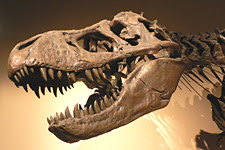I have been watching way too much CSI. For those who haven’t seen the popular American television show, it is about a team of highly skilled Crime Scene Investigators who use keen observational skills and high tech gadgetry to solve crimes each week in Las Vegas (The franchise also includes Miami and New York).
Well on the way to the coffee house yesterday my husband, Paul, spotted a trail of blood, obviously a fight at one of the local clubs the night before. I know we have been watching too much CSI because before the end of the block we had determined the trail we were examining was the result of gravitational blood splatter (GBS) from two wounds on a single victim heading up Queen’s Road. Paul wouldn’t let me keep following the trail after we got to the coffee shop so unfortunately you will have to wait to hear about my findings until I can go back to take a look.
 I found myself thinking along the same lines when I read a news article this week about a spectacular Montana find: a team of fossil hunters in the badlands of western Garfield County have found a unusual pair of creatures frozen in time: a theropod and a ceratopian dinosaur. The pair died near the coast of Montana's prehistoric sea 75 million years ago and the sediment preserved remarkable detail. The theropod resembles a Gorgosaur and the unidentified ceratopian has a frill like a triceratops but no horns. Slightly bittersweet, the theropod skeleton is marred by a single flaw: one missing claw keeps it from being 100% complete.
I found myself thinking along the same lines when I read a news article this week about a spectacular Montana find: a team of fossil hunters in the badlands of western Garfield County have found a unusual pair of creatures frozen in time: a theropod and a ceratopian dinosaur. The pair died near the coast of Montana's prehistoric sea 75 million years ago and the sediment preserved remarkable detail. The theropod resembles a Gorgosaur and the unidentified ceratopian has a frill like a triceratops but no horns. Slightly bittersweet, the theropod skeleton is marred by a single flaw: one missing claw keeps it from being 100% complete.
The discovery is believed to be one of only three that have ever captured a carnivorous and herbivorous dinosaur together, and the first in North America. As the excavators cleared the sandstone, they found four carnivore teeth lodged in the vegetarian's cervical and thoracic vertebrae (Queue: Who are you….? Who? Who? Who? Who?).
At first glance it may seem that we may have solved a millions of years old cold case but palaeontologist Nate Murphy claims that the evidence against the theropod suspect is circumstantial only. Based on the placement of the skeletons he thinks it is more likely that the two were the unfortunate victims of a flood. He believes that the herbivore was attacked before it met the suspect, who at worst was guilty of stalking its prey. I however believe the real answer may lie in the missing claw…
On another note, the discovery has stirred up the controversial issue commercial fossil hunting. Especially since some of the fossil hunters believe this discovery is in the league of "Sue," the largest and most complete T. rex found. Though Sue eventually found her home in the Chicago Field Museum, she was the center of a five year long custody battle between three parties which ended in a sale of $8 million provided through corporate sponsorship.
You can read more about the spectacular Montana find on the website of the Great Falls Tribune.
Sarda Sahney is a researcher at the University of Bristol and regularly posts on evolution, palaeontology, current controversies, biodiversity and conservation on her original site, http://fishfeet2007.blogspot.com.





Comments